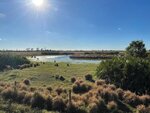A plan to preserve hundreds of thousands of acres of Florida green space started with...
Join our family of readers for as little as $5 per month and support local, unbiased journalism.
Already have an account? Log in to continue. Otherwise, follow the link below to join.
Please log in to continue |

VERO BEACH – A plan to preserve hundreds of thousands of acres of Florida green space started with the donation of 7 acres of wetland with palmetto fringe and some long-leaf trees on March 11.
On March 11 at Pelican Island, the Department of the Interior announced the establishment of the Everglades to Gulf Conservation Area in southwest Florida as the 571st and newest unit of the National Wildlife Refuge System, which is managed by the U.S. Fish and Wildlife Service. The new 4-million-acre conservation area will provide crucial protected wildlife corridors, enhance outdoor recreation access to the public and bolster climate resilience in southwest Florida.
The proposed Conservation Area abuts the Everglades Headwaters National Wildlife Refuge & Conservation Area and spans 12 counties west of Lake Okeechobee from Lakeland to Naples, including the watersheds of the Peace River, Myakka River, Fisheating Creek and Caloosahatchee River. The area is home to a diversity of species like the Floridablack bear, Everglade snail kite, Florida panther, sand skink and many other rare and endemic species, including more than 100 threatened or endangered species.
In order to officially establish a new part of the National Wildlife Refuge System, the U.S. Fish and Wildlife Service must own land in the area. Dr. Paul Gray donated 7 acres off Scarborough Road in Hardee County.
“It is a seed that gets them get going on the larger vision of 4 million acres that they may conserve up to 10% of (400,000 acres),” Gray explained.
The U.S. Fish and Wildlife Service will seek other landowners who wish to donate land, sell land or obtain conservation easements on their land.
“It is all voluntary and if landowners want to sell fee-simple or easements, they can negotiate,” Gray added.
U.S. Department of the Interior Secretary Deb Haaland, Assistant Secretary for Fish and Wildlife and Parks Shannon Estenoz, and U.S. Fish and Wildlife Service Director Martha Williams celebrated the establishment March 11 at Pelican Island National Wildlife Refuge in commemoration of the 121st birthday of the Refuge System. In 1903, President Theodore Roosevelt designated Pelican Island as the nation’s first national wildlife refuge for the protection of nesting birds that were under threat due to overharvesting for the plume industry.
“The National Wildlife Refuge System plays an invaluable role in providing vital habitat for wildlife species, offering outdoor recreation access to the public, and bolstering climate resilience across the country. Today, we celebrate the effort to preserve this working rural landscape, provide wildlife linkages, address the biodiversity crisis, and build resilience in the face of climate change, not just for our kids and grandkids, but for all future generations to come,” said Haaland.
She said restoring and conserving land and water is good for the economy and good for the country. “I learned a deep respect for the outdoor world from my dad,” Haaland continued. “I want every child to have the same connection to the great outdoors that I was gifted.”
Gray said donating to the National Wildlife Refuge system was a “no brainer” to him.
“I grew up near Kansas City, Mo.,” he explained. “My uncle had a farm that my brothers and cousins and I would go to hunt and fish and camp and gave me a basic appreciation of the outdoors. But up the road from my hometown was Loess Bluffs National Wildlife Refuge.
“The wildlife refuges is mostly in the Missouri River floodplain and has restored wetlands that fill up with migratory waterfowl, especially Snow Geese. Snow Geese are crazy. They gather in the hundreds of thousands and the whole marsh would be white with geese as far as you could see. And they are noisy and travel around in flocks of 10,000 birds. When they take off, it is deafening, and forms this huge cloud of swarming birds that just blew my young mind away.
“It burned into me how spectacular nature was and more importantly perhaps, was I learned that could work with this cool stuff for a job, a career. I went straight into wildlife biology in college and have spent my entire career working in the field. Recently I bought a ranch, because being with and managing resources is very rewarding.
An important thing, to me, about National Wildlife Refuges is you don’t have to be rich or privileged to be able to go enjoy these spectacular resources. The fact that our government invests in protecting our best places, and making sure everyone can enjoy them, is very important to me. People from around the word come to marvel at them too,
“So when I learned I could help start another refuge system effort, it was a no brainer. I have come full circle. This is a small start to something that will be much larger. And will be something that burns into another kid’s brain how special Florida is, and how special our resources are. And it will burn into the brains of their parents and communities what special things we have, and will remind our society that protecting natural Florida is worth it … and fun.”
Conservation areas are national wildlife refuges that consist primarily or entirely of conservation easements on private lands in cooperation with landowners.
Existing conservation lands and waters within this landscape already provide for public use and access, including state lands. This refuge establishment will complement those opportunities. Since 2021, the U.S. Fish and Wildlife Service has added over 500,000 acres through willing seller land acquisition and approved the potential to acquire up to 1,535,497 acres in fee-title and easements across the Refuge System.